A C-130J Super Hercules conducted a hot-pit refuel of a pair of F-22 Raptors Nov. 24 at Koror Palau International Airport using an Aerial Bulk Fuel Delivery System.
This mission was one of a series of operations associated with Westpac, a dynamic force employment of the 94th Expeditionary Fighter Squadron to the U.S. Indo-Pacific Command's area of responsibility.
According to the Air Expeditionary Force Fuels Management Pocket Guide, ABFDS is an aerial, fuels-delivery system that enables aircraft to transport fuel rapidly to locations close to or behind enemy lines. This system is normally installed on C-130s but can be used on C-5 Galaxies and C-17 Globemaster IIIs.
"Hot-pit refueling operations using ABFDS are relatively new," said Chief Master Sgt. Steve McClure, Pacific Air Forces command fuels functional manager. "The primary design of the ABFDS system is to refuel or to take bulk fuel to bladders in a contingency location. It has the capability to refuel aircraft and always has, but we've stepped that up with (agile combat employment)."
According to McClure, the 374th Airlift Wing developed the checklist to use ABFDS to refuel other aircraft, and this is the second time C-130s from the 36th Airlift Squadron, 374th Airlift Wing, Yokota Air Base, Japan, have hot-pit refueled F-22 Raptors using ABFDS. The first time was during exercise Valiant Shield 20, a biennial, U.S.-only, joint field training exercise at Andersen Air Force Base, Guam, in September.
"They've been phenomenal and worked a lot on getting us to where we're at," he said.
ABFDS supports PACAF's ACE concept, which envisions the use of agile operations to generate resilient airpower in a contested environment. The system consists of two, 3,000-gallon aerial bladder tanks, two pumping modules, a meter and hoses. It is also capable of delivering 600 gallons per minute with one pump or 1,200 gallons per minute with both pumps.
Should pilots find themselves running out of fuel and they cannot land at the airfield they departed from because it's under attack or has battle damage, the pilots can divert to a different location knowing they can get refueled.
"If that location doesn't have fuel support, we can generate a mission to fly in and off load fuel to the aircraft," McClure said.
Being able to get fuel to places in the USINDOPACOM theater of operations is important due to its size. The command's area of responsibility is more than 100 million square miles, or roughly 52% of the Earth's surface, stretching from the west coast of the United States, the west coast of India, and from the Arctic to the Antarctic, making this an important capability.
"There are more airfields than there is capability at those airfields," McClure said. "You never know when we're going to land, and you never know when we're going to need support. It offers us the opportunity to put fuel at a location in a relatively short amount of time as opposed to moving it via maritime.
"We have the capability to load fuel on an aircraft. Take that aircraft and land somewhere, refuel and get back out of there. Once all aircraft are gone, it's like we've never been there."
ABFDS has been used in other USINDOPACOM exercises and used to rotate U-2 Dragon Ladies in and out of South Korea. The system was also loaded onto Royal Australian Air Force C-17s and used to refuel a C-130 during Arctic Ace 2018.
The 94th EFS is deployed to Andersen AFB from the 1st Fighter Wing, Joint Base Langley-Eustis, Virginia.
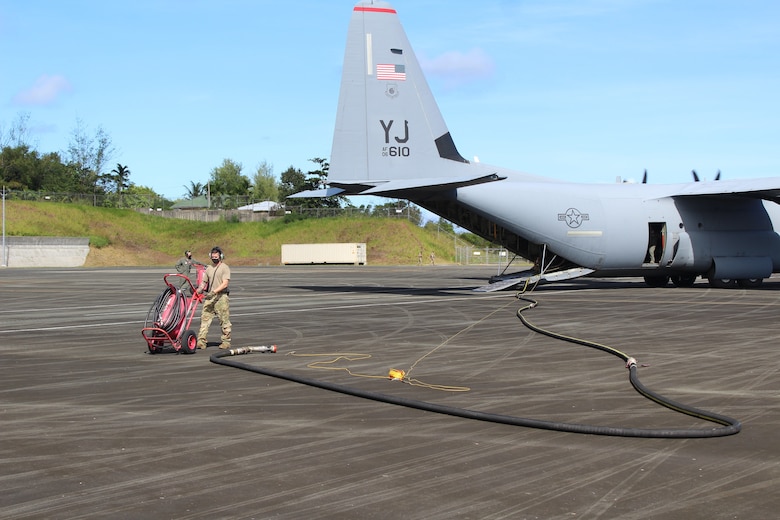
An Airman prepares to provide fuel to a U.S. Air Force C-130J Super Hercules assigned to the 36th Airlift Squadron, Yokota Air Base, Japan, during a Dynamic Force Employment on Palau, Nov. 24, 2020. DFE is an operational platform that allows our forces to be strategically predictable and operationally unpredictable. The United States security presence, along with its allies and partners, underpins the peace and stability that has enabled the Indo-Pacific region to develop and prosper for more than seven decades. (U.S. Air Force courtesy photo)
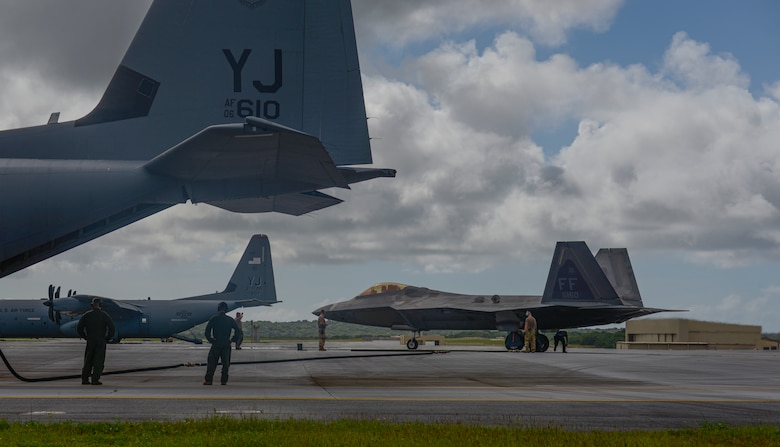
An F-22 Raptor assigned to the 94th Expeditionary Fighter Squadron completes a hot refuel from a fuel bladder carried by a C-130J Super Hercules assigned to the 36th Airlift Squadron, Yokota Air Base, Japan, during a Dynamic Force Employment at Andersen Air Force Base, Guam, Nov. 22, 2020. DFE is an operational platform that allows our forces to be strategically predictable and operationally unpredictable. The U.S. Air Force is postured and ready to respond to crises and contingencies throughout the U.S. Indo-Pacific Command, contributing to regional stability and a free and open Indo-Pacific. (U.S. Air Force photo by Senior Airman Michael S. Murphy)
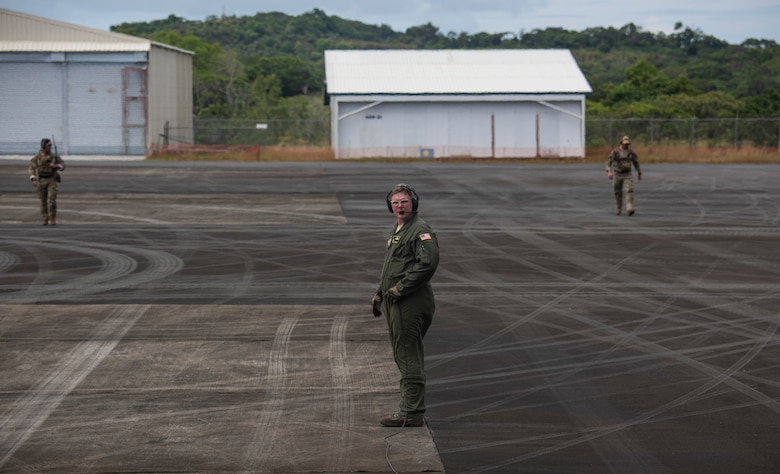
Chief Master Sgt. Lester Farley, a loadmaster assigned to the 36th Airlift Squadron, Yokota Air Base, Japan, calls in two 736th Security Forces Airmen from a security perimeter before takeoff at Palau International Airport, Palau, during a Dynamic Force Employment, Nov. 23, 2020. DFE is an operational platform that allows our forces to be strategically predictable and operationally unpredictable. The U.S. Air Force is postured and ready to respond to crises and contingencies throughout the U.S. Indo-Pacific Command, contributing to regional stability and a free and open Indo-Pacific. (U.S. Air Force photo by Senior Airman Michael S. Murphy)
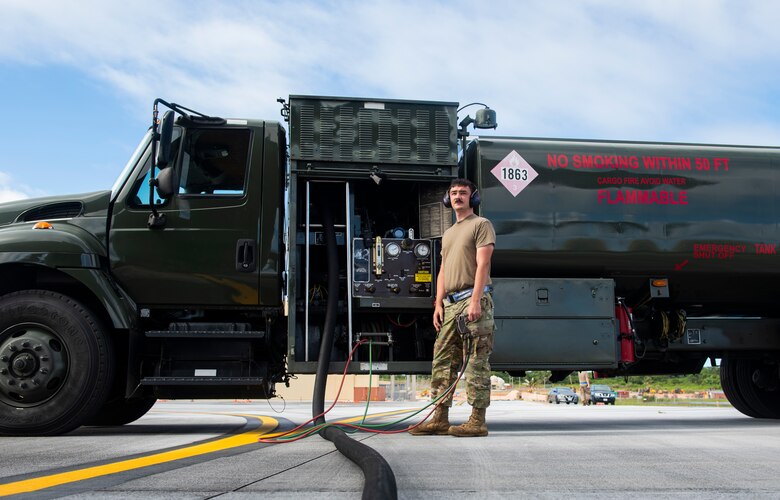
An Airman assigned to the 36th Logistics Readiness Squadron provides fuel to a U.S. Air Force C-130J Super Hercules assigned to the 36th Airlift Squadron, Yokota Air Base, Japan, during a Dynamic Force Employment at Andersen Air Force Base, Guam, Nov. 22, 2020. DFE is an operational platform that allows our forces to be strategically predictable and operationally unpredictable. The United States security presence, along with our allies and partners, underpins the peace and stability that has enabled the Indo-Pacific region to develop and prosper for more than seven decades. (U.S. Air Force photo by Senior Airman Michael S. Murphy)
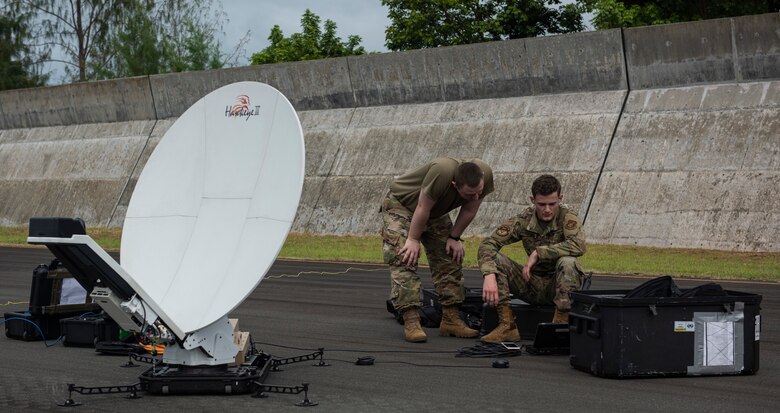
Staff Sgt. Daniel Steuer, left, a system supervisor assigned to the 374th Communications Squadron, Yokota Air Base, Japan, and Airman 1st Class Kinsley Noel, a 374th CS radio frequency technician, set up a Hawkeye satellite at Babelthuap, Palau, during a Dynamic Force Employment, Nov. 23, 2020. DFE is an operational platform that allows our forces to be strategically predictable and operationally unpredictable. (U.S. Air Force photo by Senior Airman Michael S. Murphy)

Airman 1st Class Kim Doyle, a loadmaster assigned to the 36th Airlift Squadron, Yokota Air Base, Japan, observes the island of Palau before arrival over the Indo-Pacific during a Dynamic Force Employment, Nov. 23, 2020. DFE is an operational platform that allows our forces to be strategically predictable and operationally unpredictable. The U.S. Air Force is postured and ready to respond to crises and contingencies throughout the U.S. Indo-Pacific Command, contributing to regional stability and a free and open Indo-Pacific. (U.S. Air Force photo by Senior Airman Michael S. Murphy)






